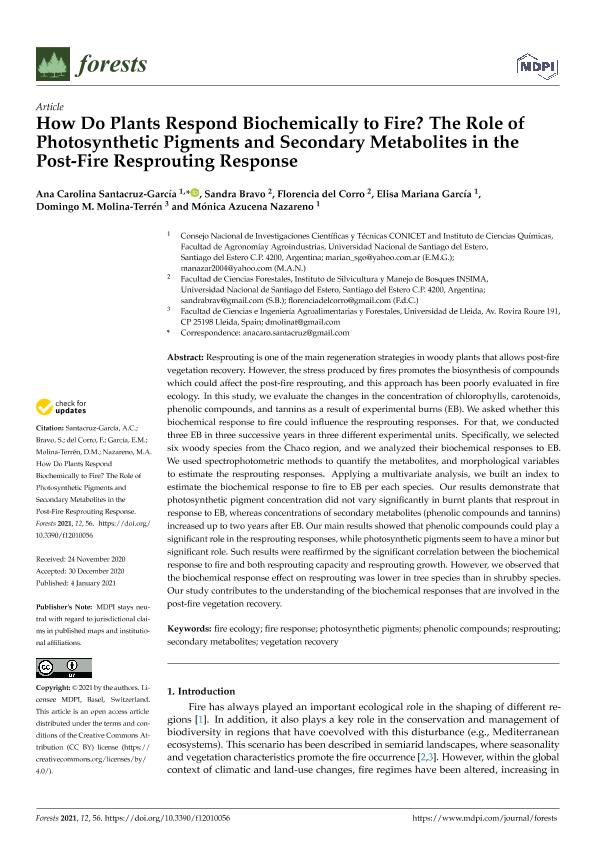Mostrar el registro sencillo del ítem
dc.contributor.author
Santacruz García, Ana Carolina

dc.contributor.author
Bravo, Sandra

dc.contributor.author
del Corro, Florencia Inés

dc.contributor.author
García, Elisa Mariana

dc.contributor.author
Molina Terrén, Domingo M.
dc.contributor.author
Nazareno, Mónica Azucena

dc.date.available
2021-12-09T13:23:59Z
dc.date.issued
2021-01
dc.identifier.citation
Santacruz García, Ana Carolina; Bravo, Sandra; del Corro, Florencia Inés; García, Elisa Mariana; Molina Terrén, Domingo M.; et al.; How do plants respond biochemically to fire? The role of photosynthetic pigments and secondary metabolites in the post-fire resprouting response; MDPI AG; Forests; 12; 1; 1-2021; 1-20
dc.identifier.issn
1999-4907
dc.identifier.uri
http://hdl.handle.net/11336/148476
dc.description.abstract
Resprouting is one of the main regeneration strategies in woody plants that allows post-fire vegetation recovery. However, the stress produced by fires promotes the biosynthesis of compounds which could affect the post-fire resprouting, and this approach has been poorly evaluated in fire ecology. In this study, we evaluate the changes in the concentration of chlorophylls, carotenoids, phenolic compounds, and tannins as a result of experimental burns (EB). We asked whether this biochemical response to fire could influence the resprouting responses. For that, we conducted three EB in three successive years in three different experimental units. Specifically, we selected six woody species from the Chaco region, and we analyzed their biochemical responses to EB. We used spectrophotometric methods to quantify the metabolites, and morphological variables to estimate the resprouting responses. Applying a multivariate analysis, we built an index to estimate the biochemical response to fire to EB per each species. Our results demonstrate that photosynthetic pigment concentration did not vary significantly in burnt plants that resprout in response to EB, whereas concentrations of secondary metabolites (phenolic compounds and tannins) increased up to two years after EB. Our main results showed that phenolic compounds could play a significant role in the resprouting responses, while photosynthetic pigments seem to have a minor but significant role. Such results were reaffirmed by the significant correlation between the biochemical response to fire and both resprouting capacity and resprouting growth. However, we observed that the biochemical response effect on resprouting was lower in tree species than in shrubby species. Our study contributes to the understanding of the biochemical responses that are involved in the post-fire vegetation recovery.
dc.format
application/pdf
dc.language.iso
eng
dc.publisher
MDPI AG
dc.rights
info:eu-repo/semantics/openAccess
dc.rights.uri
https://creativecommons.org/licenses/by-nc-sa/2.5/ar/
dc.subject
FIRE ECOLOGY
dc.subject
FIRE RESPONSE
dc.subject
PHENOLIC COMPOUNDS
dc.subject
PHOTOSYNTHETIC PIGMENTS
dc.subject
RESPROUTING
dc.subject
SECONDARY METABOLITES
dc.subject
VEGETATION RECOVERY
dc.subject.classification
Bioquímica y Biología Molecular

dc.subject.classification
Ciencias Biológicas

dc.subject.classification
CIENCIAS NATURALES Y EXACTAS

dc.title
How do plants respond biochemically to fire? The role of photosynthetic pigments and secondary metabolites in the post-fire resprouting response
dc.type
info:eu-repo/semantics/article
dc.type
info:ar-repo/semantics/artículo
dc.type
info:eu-repo/semantics/publishedVersion
dc.date.updated
2021-12-03T20:21:15Z
dc.journal.volume
12
dc.journal.number
1
dc.journal.pagination
1-20
dc.journal.pais
Suiza

dc.journal.ciudad
Lausanne
dc.description.fil
Fil: Santacruz García, Ana Carolina. Universidad Nacional de Santiago del Estero. Facultad de Agronomía y Agroindustrias; Argentina. Consejo Nacional de Investigaciones Científicas y Técnicas. Centro Científico Tecnológico Conicet - Tucumán; Argentina
dc.description.fil
Fil: Bravo, Sandra. Universidad Nacional de Santiago del Estero; Argentina
dc.description.fil
Fil: del Corro, Florencia Inés. Universidad Nacional de Santiago del Estero. Facultad de Ciencias Forestales. Instituto de Silvicultura y Manejo de Bosques; Argentina. Consejo Nacional de Investigaciones Científicas y Técnicas. Centro Científico Tecnológico Conicet - Tucumán; Argentina
dc.description.fil
Fil: García, Elisa Mariana. Consejo Nacional de Investigaciones Científicas y Técnicas. Centro de Investigaciones y Transferencia de Santiago del Estero. Universidad Nacional de Santiago del Estero. Centro de Investigaciones y Transferencia de Santiago del Estero; Argentina
dc.description.fil
Fil: Molina Terrén, Domingo M.. Universitat de Lleida; España
dc.description.fil
Fil: Nazareno, Mónica Azucena. Instituto de Investigacion y Estudios En Enseñanzas de Las Ciencias (iieec) ; Facultad de Agronomia y Agroindustrias ; Universidad Nacional de Santiago del Estero; Argentina. Consejo Nacional de Investigaciones Científicas y Técnicas. Centro Científico Tecnológico Conicet - Tucumán; Argentina
dc.journal.title
Forests
dc.relation.alternativeid
info:eu-repo/semantics/altIdentifier/url/https://www.mdpi.com/1999-4907/12/1/56/pdf
dc.relation.alternativeid
info:eu-repo/semantics/altIdentifier/doi/https://doi.org/10.3390/f12010056
Archivos asociados
